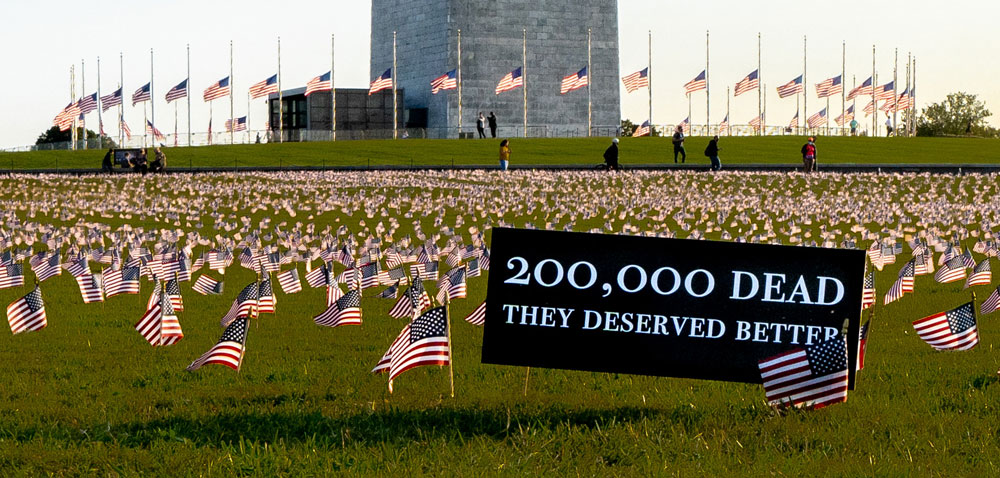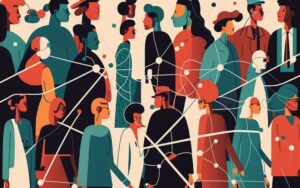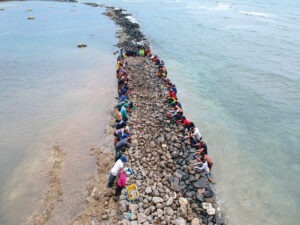
December 7, 2020; Washington Post
As the US death toll from COVID-19 nears the 300,000 mark, one obvious point that seems forgotten among the others is the lack of official recognition of the loss.
At NPQ, we marked the point when US pandemic deaths crossed the 100,000 mark and did so again mere weeks ago when the US death toll passed a quarter-million. We’ve addressed the presence of grief and stress in the nonprofit sector. We’ve also written about the traumatic impact on care workers, and strategies such as theater productions to process that trauma.
We haven’t covered memorials, however, in part because the nation has largely failed to honor its dead. As David Montgomery observes in the Washington Post, “There have been few formal acknowledgments of the lives lost and of the anguish of those left behind—unlike, say, after the September 11, 2001, terrorist attacks, which killed approximately 3,000 people. No consoling presidential addresses. No flags at half-staff.” This is true even though, as Montgomery observes, the “mental health consequences of so much sudden death in so short a time could be dire.”
But, as Montgomery points out, the lack of memorials emanating from on high has not prevented a slew of unofficial memorials by communities across the country.
In the nation’s capital, for instance, upon the blocks-long green in front of RFK Stadium, which once housed Washington’s National Football League team but is now slated to be razed in 2021, “the grass had been planted with thousands of white pennants, one for every person in the United States killed by the coronavirus.” The display, explains Montgomery, is the work of Bethesda-based artist Suzanne Brennan Firstenberg. The artist’s website says the installation was slated to be taken down after November 30th, although a December 1st newsletter from RFK Fields praises the exhibit and makes no mention of plans to dismantle it.
Sign up for our free newsletters
Subscribe to NPQ's newsletters to have our top stories delivered directly to your inbox.
By signing up, you agree to our privacy policy and terms of use, and to receive messages from NPQ and our partners.
“This had to happen because people have nowhere to put their grief,” Firstenberg tells Montgomery. “They need society to acknowledge that they’ve lost a loved one.”
The DC makeshift memorial is not unique. Montgomery reports, “In Philadelphia, 862 chairs—one for every 10 of more than 8,600 deaths reported in Pennsylvania at the time”—sat empty as part of an installation on Independence Mall that was created in October. The Philadelphia effort was a collective one, designed by a group called COVID Survivors for Change.
A third example Montgomery cites is found in New York City at a small park on Broadway, south of Times Square, where mourners weave yellow and white roses into fragrant flower chains. Montgomery relates that “artist Kristina Libby taught us how to loop twine around the stems to connect the blossoms,” adding, “Since April, Libby has been leaving hearts fashioned from rose garlands around New York City.” The effort Libby founded is now called the Floral Heart Project.
Montgomery notes that there are some similarities between the popular response of families of those fallen to COVID-19 and the response of families to the loss of loved ones to HIV-AIDS. The AIDS Memorial Quilt, after all, began as a small effort that snowballed over time into the largest ongoing community folk arts project in the world, as well as inspiring activists to mobilize against the disease and homophobia.
There is a similar link to activism among the artists and mourners behind the COVID memorials. Montgomery explains that when he visited Libby, a small group of mourners were at the park, sharing their stories. One of them was Fiana Tulip, whose mother, Isabelle Papadimitriou, 64, was a Dallas respiratory therapist who died from COVID-19 on July 4th. Tulip in her remarks observes that, “we must come together as a united front to support each other.”
Tulip adds that, “Those we have lost to COVID deserve notice, and they deserve reverence…it’s time to remember what has happened so far [to] spread love and warmth in a world that is riddled with pain and that feels so empty right now.”—Steve Dubb












